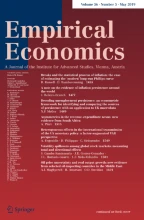Abstract
Variation in the price of steel is an important factor to take into consideration when discussing cost control and management decisions in the construction industry. We employ various conventional and advanced econometrics methods to examine the interrelationships of steel prices in three related markets during the time period June 2002 to May 2010: Mainland China (CH), Taiwan (TW), and the United States (US). We adopt the Gregory and Hansen (GH) test and regime-switching (RS) model for cointegration, both of which accommodate endogenous structural break(s), to produce a more accurate analysis of a period in the presence of structural change(s). The empirical result of the RS cointegration test with respect to multiple structural breaks suggests a long-run equilibrium relationship among the three variables considered. This finding differs from the result of the GH test but confirms the result of the conventional Johansen test. Furthermore, the results of the Granger causality test indicate that both CH and US steel prices have great influence on the TW steel price; the Taiwanese steel market is closely linked with China and US steel markets in the long run.
Similar content being viewed by others
References
Akintoye SA, Skitmore RM (1994) A comparative analysis of the three macro price forecasting models. Constr Manage Econ 12(3): 257–270
Clements MP, Hendry DF (1999) On Winning Forecasting Competitions in Economics. Span Econ Rev 1: 123–160
Davies A (2006) Testing for international equity market integration using regime switching cointegration techniques. Rev Financ Econ 15(4): 305–321
Dickey DA, Fuller WA (1981) Likelihood ratio statistics for autoregressive time series with a unit root. Econometrica 49: 1057–1072
Dolado JJ, Jenkinson T, Sosvilla-Rivero S (1990) Cointegration and unit roots. J Econ Surv 4: 249–273
Engle R, Granger C (1987) Co-integration and error correction representation, estimation and testing. Econometrica 55: 251–267
Fitzgerald E, Akintoye A (1995) The accuracy and optimal linear correction of UK construction tender price index forecasts. Constr Manage Econ 13(6): 493–500
Gabriel VJ, Psaradakis Z, Sola M (2002) A simple method of testing for cointegration subject to multiple regime changes. Econ Lett 76(2): 213–221
Gonzalo J (1994) Five alternative methods of estimating long-run equilibrium relationships. J Economet 60: 203–233
Granger CWJ (1969) Investigating causal relations by econometric models and cross-spectral methods. Econometrica 37: 24–36
Granger CWJ (1988) Some recent developments in a concept of causality. J Economet 39: 199–211
Gregory A, Hansen B (1996) Residual-based tests for cointegration in models with regime shifts. J Economet 70: 99–126
Hamilton JD (1994) Time series analysis. Princeton University Press, Princeton
Huang YC, Yang HA, Wang CH (2002) Increasing forecast accuracy of Taiwan construction cost indices by structural dummy variable. J Chin Inst Civ Hydraul Eng 14(4): 651–658
Johansen S (1988) Statistical analysis of cointegration vectors. J Econ Dyn Control 12: 231–254
Johansen S (1992) Determination of cointegration rank in the presence of a linear trend. Oxf Bull Econ Stat 54(3): 383–397
Johansen S (1994) The role of the constant and linear terms in cointegration analysis of nonstationary variables. Economet Rev 13(2): 205–229
Johansen S, Juselius K (1990) Maximum likelihood estimation and inference on cointegration with applications to the demand for money. Oxf Bull Econ Stati 52(2): 169–210
Liebman BH (2006) Safeguards, China, and the price of steel. Rev World Econ 142(2): 354–373
Lucey BM, Svitlana V (2008) Russian equity market linkages before and after the 1998 crisis: Evidence from stochastic and regime-switching cointegration tests. J Int Money Finan 27: 1303–1324
Mackinnon JG (1996) Numerical distribution functions for unit root and cointegration tests. J Appl Econ 11: 601–618
Newey W, West K (1994) Automatic lag selection in covariance matrix estimation. Rev Econ Stud 61: 631–653
Ng S, Perron P (2001) Lag length selection and the construction of unit root tests with goof size and power. Econometrica 69: 1519–1554
Ng ST, Cheung SO, Skitmore M, Wong TCY (2004) An integrated regression analysis and time series model for construction tender price index forecasting. Constr Manage Econ 22(5): 483–493
Nieh CC, Lee CF (2001) Dynamic relationship between stock prices and exchange rates for G-7 countries. Q Rev Econ Finan 41: 477–490
Osterwald-Lenum M (1992) Practitioner’s corner—a note with quantiles of the asymptotic distribution of the maximum likelihood cointegration rank test statistics. Oxf Bull Econ Stat 54: 461–472
Pantula SG (1989) Testing for unit roots in time series data. Econometric Theory 5: 256–271
Perron P (1989) The great crash, the oil price shock and the unit root hypothesis. Econometrica 57: 1361–1401
Phillips PCB, Perron P (1988) Testing for a unit root in time series regression. Biometrika 75: 335–346
Runeson KG (1988) Methodology and method for price-level forecasting in the building industry. Constr Manage Econ 6(1): 49–55
Schwert GW (1989) Tests for unit roots: a Monte Carlo investigation. J Bus Econ Stat 7: 147–159
Taylor RG, Bowen PA (1987) Building price-level forecasting: an examination of techniques and application. Constr Manage Econ 5(1): 21–44
Vandenbussche H, Zarnic Z (2008) US safeguards on steel and the markups of European producers. Rev World Econ 144(3): 458–490
Wang CH, Mei YH (1998) Model for forecasting construction cost indices in Taiwan. Constr Manage Econ 16: 147–157
Zivot E, Andrews DWK (1992) Further evidence on the great crash, the oil price shock, and the unit root hypothesis. J Bus Econ Stat 10: 251–270
Author information
Authors and Affiliations
Corresponding author
Rights and permissions
About this article
Cite this article
Nieh, CC., Yau, HY., Hung, K. et al. Cointegration and causal relationships among steel prices of Mainland China, Taiwan, and USA in the presence of multiple structural changes. Empir Econ 44, 545–561 (2013). https://doi.org/10.1007/s00181-012-0556-6
Received:
Accepted:
Published:
Issue Date:
DOI: https://doi.org/10.1007/s00181-012-0556-6
